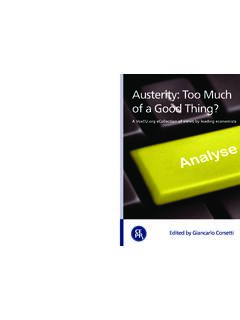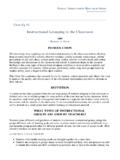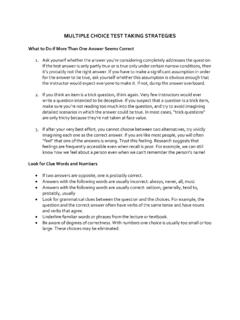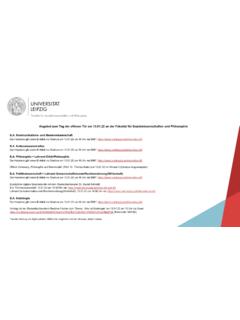Transcription of Economics in the Time of COVID-19 - VoxEU
1 Economics in the Economics in the time of COVID-19 . time of COVID-19 . Edited by Richard Baldwin and beatrice Weder di Mauro Centre for economic Policy Research A Book 33 Great Sutton Street London EC1V 0DX. CEPR Press Tel: +44 (0)20 7183 8801. Email: CEPR Press Economics in the time of COVID-19 . CEPR Press Centre for economic Policy Research 33 Great Sutton Street London, EC1V 0DX. UK. Tel: +44 (0)20 7183 8801. Email: Web: ISBN: 978-1-912179-28-2. Copyright CEPR Press, 2020. Economics in the time of COVID-19 . Edited by Richard Baldwin and beatrice Weder di Mauro A CEPR Press eBook CEPR Press The views expressed in this book are those of the authors and not those of CEPR. or any of the institutions with which the authors are affiliated. The editors would like to acknowledge the important and timely contribution of research assistance from Guilia Sabbatini and Anmol Kaur Grewal, together with Anil Shamdasani and Sophie Roughton's hard work on production to enable this eBook to be produced so quickly.
2 Centre for economic Policy Research (CEPR). The Centre for economic Policy Research (CEPR) is a network of over 1,500 research economists based mostly in European universities. The Centre's goal is twofold: to promote world-class research, and to get the policy-relevant results into the hands of key decision-makers. CEPR's guiding principle is Research excellence with policy relevance'. A registered charity since it was founded in 1983, CEPR is independent of all public and private interest groups. It takes no institutional stand on economic policy matters and its core funding comes from its Institutional Members and sales of publications. Because it draws on such a large network of researchers, its output reflects a broad spectrum of individual viewpoints as well as perspectives drawn from civil society.
3 CEPR research may include views on policy, but the Trustees of the Centre do not give prior review to its publications. The opinions expressed in this report are those of the authors and not those of CEPR. Chair of the Board Sir Charlie Bean Founder and Honorary President Richard Portes President beatrice Weder di Mauro Vice Presidents Maristella Botticini Ugo Panizza Philippe Martin H l ne Rey Chief Executive Officer Tessa Ogden Contents Introduction 1. Richard Baldwin and beatrice Weder di Mauro 1 Macroeconomics of the flu 31. beatrice Weder di Mauro 2 Tackling the fallout from COVID-19 37. Laurence Boone, David Haugh, Nigel Pain and Veronique Salins 3 The economic impact of COVID-19 45. Warwick McKibbin and Roshen Fernando 4 Novel coronavirus hurts the Middle East and North Africa through many channels 53.
4 Rabah Arezki and Ha Nguyen 5 Thinking ahead about the trade impact of COVID-19 59. Richard Baldwin and Eiichi Tomiura 6 Finance in the times of coronavirus 73. Thorsten Beck 7 Contagion: Bank runs and COVID-19 77. Stephen G. Cecchetti and Kermit L. Schoenholtz 8 Real and financial lenses to assess the economic consequences of COVID-19 81. Catherine L. Mann 9 As coronavirus spreads, can the EU afford to close its borders? 87. Raffaella Meninno and Guntram Wolff 10 Trade and travel in the time of epidemics 93. Joachim Voth 11 On plague in a time of Ebola 97. Cormac Gr da 12 Coronavirus monetary policy 105. John H. Cochrane 13 The economic effects of a pandemic 109. Simon Wren-Lewis 14 The good thing about coronavirus 113. Charles Wyplosz Introduction Richard Baldwin and beatrice Weder di Mauro Graduate Institute, Geneva and CEPR.
5 COVID-19 is spreading human suffering worldwide; that is what we should all be focused on. But we are not doctors. We are economists and COVID-19 is most definitely spreading economic suffering worldwide. The virus may in fact be as contagious economically as it is medically. Joining the OECD's dire growth forecast of 2 March 2020, the European Commission said on 4 March 2020 that both Italy and France are at risk of slipping into recession, and the IMF said it sees more dire possibilities ahead for the global economy. This book is an extraordinary effort for extraordinary times. On Thursday 27 February, we emailed a group of leading economists to see if they'd contribute to the effort. The authors responded and the eBook came together literally over the weekend (the deadline for contributions was Monday 2 March 2020).
6 The eBook is a testimony to the power of collaboration in a network that has the size, speed, flexibility, and talent of CEPR. The key economic questions addressed in the book are: How, and how far and fast, will the economic damage spread? How bad will it get? How long will the damage last? What are the mechanisms of economic contagion? And, above all, what can governments do about it? Extraordinary times Just six weeks ago, the world economy seemed well on the way to a nice recovery; trade and political tensions were seen as not so bad , growth projections were rosy, and financial markets were cheery. Now all bets are off. As COVID-19 spreads around the globe, it has become clear that it has the potential to derail the world economy. 1. Economics in the time of COVID-19 .
7 The size and persistence of the economic impact is unknowable. Like a healthy person who catches the seasonal flu, suffers a nasty but short-lived discomfort, and is quickly back to full power, the crisis could be short and sharp. Such a V-shaped' hit seemed likely when COVID-19 was essentially a Chinese problem and China was dealing with it forcefully. Times have changed. While a short-and-sharp crisis is still possible, it's looking less like the most likely outcome. The disease is spreading rapidly in dozens of countries. Three chapters in the eBook put numbers to this, and we'll summarise those below, but the bottom line is that while there is too much uncertainty to be certain about outcomes, it is clear that this economic shock could cause lingering pain and perhaps leave deep scars far larger than the other post-war pandemics (see Box 1 for a list).
8 The shock hits G7 plus China This pandemic is different, economically speaking. Previous post-war pandemics (Box 1) hit nations that were at the time far less economically dominant. And those pandemics were far smaller; the number of COVID-19 case is already eight or nine times larger than the number of SARS cases. At least as important is one sobering fact: this time , the hardest-hit nations include the G7 plus China (see Table 1). Medical data changes hourly, but as of 5 March 2020, the ten nations hit hardest by COVID-19 is almost identical to the list of the ten largest economies in the world (Iran and India are the exceptions). The US, China, Japan, Germany, Britain, France, and Italy are all in the top-ten most affected by the disease.
9 While China is by far the hardest hit, the last few days have seen an exponential growth of cases in the G7 economies. Taking just the US, China, Japan, Germany, Britain, France, and Italy, they account for: 60% of world supply and demand (GDP). 65% of world manufacturing, and 41% of world manufacturing exports. To paraphrase an especially apt quip: when these economies sneeze, the rest of the world will catch a cold. These economies especially China, Korea, Japan, Germany and the US are also part of global value chains, so their woes will produce supply-chain contagion' in virtually all nations. 2. Table 1 Large economies and COVID-19 (updated 29 February 2020). Manufactured GDP Manufacturing Exports COVID19 cases COVID-19 deaths exports US 24% 16% 8% 8% 159 11.
10 China 16% 29% 13% 18% 80,410 2,991. Japan 6% 8% 4% 5% 331 6. Germany 5% 6% 8% 10% 262 - UK 3% 2% 2% 3% 85 - France 3% 2% 3% 4% 285 4. India 3% 3% 2% 2% 28 - Italy 2% 2% 3% 3% 3,089 107. Brazil 2% 1% 1% 1% 4 4. Canada 2% 0% 2% 2% 34 - Sources: World Bank World DataBank, FT COVID dashboard ( ). 3. Richard Baldwin and beatrice Weder di Mauro Introduction Economics in the time of COVID-19 . This pandemic is different in another way. Manufacturing sector gets a triple hit The manufacturing sector is likely to get a triple hit. 1. Direct supply disruptions will hinder production, since the disease is focused on the world's manufacturing heartland (East Asia) and spreading fast in the other industrial giants the US and Germany. 2. Supply-chain contagion will amplify the direct supply shocks as manufacturing sectors in less-affected nations find it harder and/or more expensive to acquire the necessary imported industrial inputs from the hard-hit nations, and subsequently from each other.






